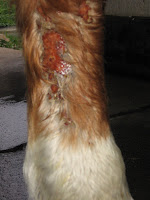But, I must say, my favorite gift this year was a short ride across the street from the stables to the Columbia River park known as Willow Grove. The weather was warm and mild, just under 60 degrees on Christmas Eve. The sun was shining and dropping lower as I began riding in late afternoon. I knew it would be the last day for a while that I would have both the time and the good weather to ride. As I write this, the rain is coming down in buckets, the wind churning as it rings the chimes just outside my window.
The river was calm and the park almost deserted, everyone undoubtedly running around, anxious to put the finishing touches on their Christmas celebrations. I couldn't believe how fortunate I was, how far I had come in my horsemanship and riding. Each time I take Chanty to the park alone, I marvel at how far we've come. She walks slowly down the driveway, crosses the road and up the sandy path that leads to a flat stretch of grass that overlooks the park and is the first view of the river. It's gorgeous and I can now appreciate it fully because I am not focused on slowing my horse. We walk together, our movements in sync. My lower back flexes, my hip,knee and ankle joints gently opening and closing. My contact with the bit in Chanty's mouth is minimal and easily goes forward and back as she vibrates her breath softly across her lips. It is the sound of contentment and I now see the calm confident horse in her that I had dreamed of 6 years ago when I first brought her to this park, kicking and screaming. Back then, she ran in fear and I pulled hard on her mouth, convinced she was misbehaving and needed only to be overpowered by me, gripping and grabbing, bracing every muscle in my body, draped across her back, like the predator I was.
As recently as this past month, I have begun incorporating more focused movement of the lower back, the lumbosacral joint into my riding and emphasizing it during my lessons with students. It is the bridge between the alternating hip movement of the lower body with hips, knees and ankles flexing and the absorption of movement up the spine of the back, through the shoulders and arms, rippling into the neck and upper spine as it connects to the head at "the poll" just between the ears. The spine connects to the pelvis with a joint that allows for forward and back as well as side to side movement. It has not always been emphasized in the descriptions of centered riding or even in my recent studies of the psoas OR it was assumed that this joint was the source of "engagement" of the deep centering muscles of the psoas. In any case, the more I focus on and make myself aware of that body part, the more my conscious competence in using the joint has grown. I am almost at the point at which I can ride without picturing my lower back during a transition or turn, the most important time to keep the movement free and flowing. Not only is the ride easier and smoother for both of us, there is no pain from straining outside muscles previously used to unnecessarily brace and balance on Chanty-no pain for me OR her.
We walked, we cantered and we returned to the stables with the same calm, confident attitude that carried us out just an hour earlier. Now as I returned from our ride, I stepped out of the saddle, hugged Chanty and genuinely showered her with affection and appreciation-no pulling, no racing, no harsh words.
She has given me so many things over the years, but this year I was given a Christmas gift that I will not soon forget. It really is all about the relationship with the horse, creating harmonious movement between two living creatures and it gets better and better every year. I can't wait for the New Year to see what treasures are waiting for me with the horses in my life.







 What could have potentially been a deadly infection has turned out to be a controlled skin condition that I'm hoping will heal up as fast as it broke out. Rose is going to be moving to my best friend's place nearby for her 2nd and final retirement. All attempts to ride her have been futile, as her shoulder arthritis is very debilitating for her if she tries to do more than a trot and especially with a rider on her back. Ironically, her feet have done wonderfully with the trim and she no longer stands with her weight forward due to painful heels. Her toe walking now is from the stiffness in her shoulders from years of walking incorrectly.
What could have potentially been a deadly infection has turned out to be a controlled skin condition that I'm hoping will heal up as fast as it broke out. Rose is going to be moving to my best friend's place nearby for her 2nd and final retirement. All attempts to ride her have been futile, as her shoulder arthritis is very debilitating for her if she tries to do more than a trot and especially with a rider on her back. Ironically, her feet have done wonderfully with the trim and she no longer stands with her weight forward due to painful heels. Her toe walking now is from the stiffness in her shoulders from years of walking incorrectly.